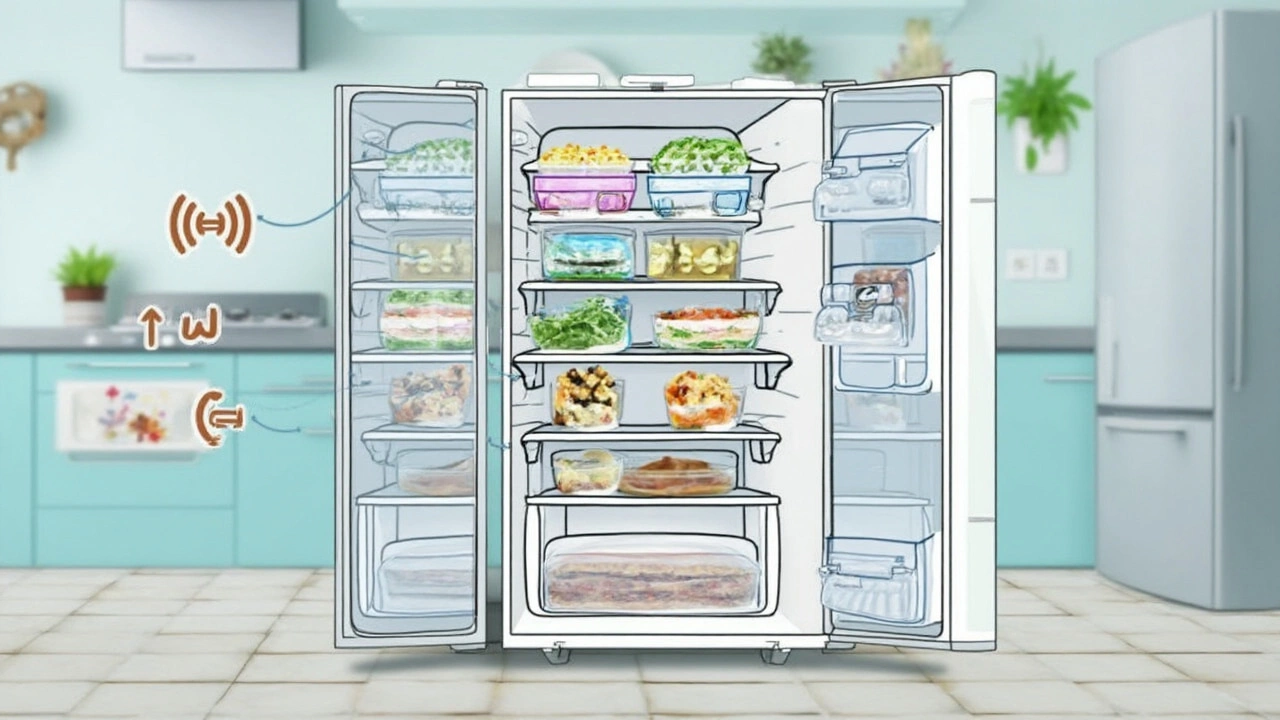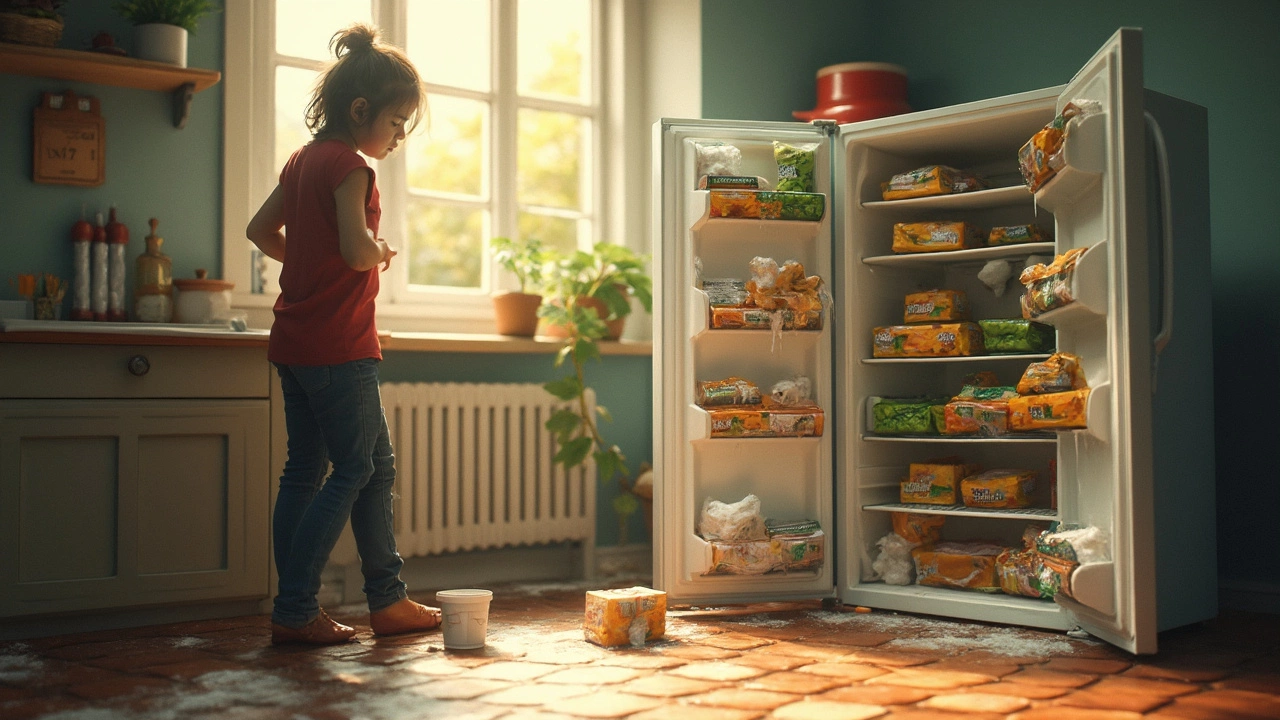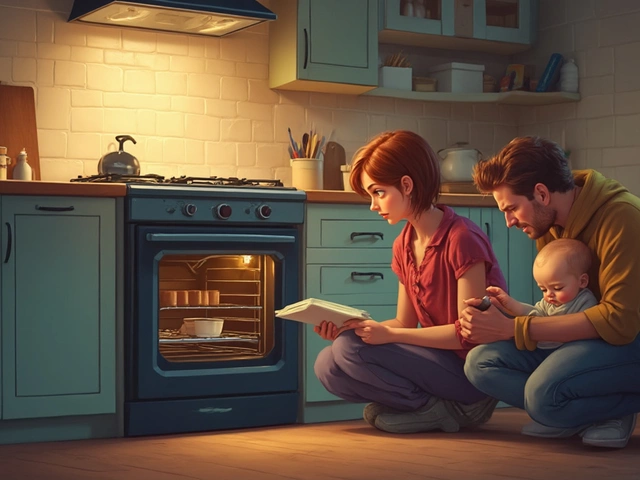Nothing quite ruins your day like frozen pizza turning mushy or your ice cubes coming out as sad puddles. So, what’s going on when your freezer just can’t keep cool?
The truth is, freezers are a lot fussier than you’d expect. Sometimes, it’s something super basic: maybe the door didn’t close all the way, or someone stuffed too much in and blocked the vents. Other times, the cause hides deeper—like a dying thermostat or a weak door seal that lets warm air creep in when you’re not looking.
First things first, check the obvious stuff. Is the power cord still snug in the outlet? Has a breaker tripped? Believe it or not, the classic "jiggle the plug" move still solves more problems than you’d think. If that’s not it, peek at the temperature dial—in some freezers, just a tiny bump can nudge the temp up enough so nothing freezes right. No luck? Don’t walk away yet. There are other sneaky fixes you can try before calling in reinforcements.
- Common Freezer Slip-Ups
- How Your Freezer Actually Works
- Faulty Seals and Doors
- The Trouble with Thermostats
- Airflow Blockages and Frost Buildup
- When to Call for Backup
Common Freezer Slip-Ups
You’d be surprised by how many freezer repair calls start with something small that got overlooked. Most problems don’t need a toolbox—just a minute of paying attention. Let’s break down what usually goes wrong.
First off, the door. If it’s not closing tight every time, your freezer’s fighting a losing battle. Something as simple as a bag of frozen peas poking out can keep the door cracked, and warm air sneaks in quicker than you think. The same goes for a freezer that’s overpacked or, on the flip side, almost empty—both mess with how cold air moves around. Either way, your ice cream will tell the story (melty edges are a dead giveaway).
- Unsealed doors: A small gap can ruin everything. Check for bags or food blocking the seal every time you shut it.
- Overloading: Shoving in groceries so the shelves groan? Cold air can’t flow, and pockets of warm form in between all that frozen food.
- Too empty: With barely anything inside, there’s not enough thermal mass to hold the cold, so it heats up quickly whenever you open the door.
- Wrong temperature setting: Kids messing with knobs, or bumping the dial by accident, can set your freezer higher than it needs to be—check that it's set to 0ºF (-18ºC), the gold standard for frozen food safety, according to the FDA.
- Blocked vents: Every freezer has vents for circulating air. Keep them clear, or you’re just asking for trouble.
Stats don’t lie: About 30% of freezer not freezing complaints come down to user error—usually something on this list. Backing that up, the Association of Home Appliance Manufacturers says that “most freezer performance issues are traced back to door and airflow problems.”
“A blocked vent or a loose door seal will cause temperatures to fluctuate, leading to frost or completely thawed food,” says appliance technician Mark Jenkins (AHAM interview, April 2024).
Quick tip: Don’t forget to check for stuff jammed behind the freezer, like boxes or cleaning supplies. If the coils or air intake are covered, the freezer can’t breathe, which means less freezing power.
How Your Freezer Actually Works
Ever wonder how your freezer keeps things frozen solid? It’s not magic—it’s a science that relies on a few key parts working together. At the heart of it, your freezer pulls heat out of the inside and dumps it outside, usually through the coils on the back or bottom.
Here’s the basic breakdown:
- Compressor: This acts like a pump, pushing cold refrigerant through the system. If this guy’s struggling, the whole freezing process slows down.
- Condenser Coils: Heat from inside the freezer gets dumped out here. If these coils get all dusty or dirty, they can’t do their job and everything inside gets warmer.
- Evaporator Coils: These sit inside the freezer, absorbing heat from the air and letting cold air move around your food.
- Thermostat: Sets the temp you want and makes the compressor kick on or off to keep everything at that level.
- Fans: Move cold air around. If these fans stop spinning, you might get frost in some spots and warm patches in others.
Modern freezer repair experts look for these common trouble spots first, since a problem in any one of them can mess up the whole process. If your freezer just hums but things aren’t getting colder, it’s often the compressor or coils acting up.
Fun fact: Most freezers keep food safest at or below 0°F (-18°C). The U.S. FDA backs this up—and food kept around this range stays fresh longer and safe from bacteria that love milder temps. Here’s what different temps in your freezer can mean for your food:
| Freezer Temp (°F) | Result |
|---|---|
| 0°F | Safe food storage, solid freeze |
| 10°F | Slow thawing, short storage |
| 20°F | Partial thaw, unsafe long term |
So, if your chicken nuggets start to soften or your ice cream isn’t rock hard, your freezer isn’t getting down to where it needs to be. That means there’s a real issue somewhere in this lineup of parts. Don’t ignore the early clues—catching these hiccups early makes freezer repair way easier down the road.
Faulty Seals and Doors
If your freezer’s door seal isn’t working right, it’s going to let warm air sneak in. That kills your freeze faster than you’d expect. Freezer door seals—technically called gaskets—are super important for keeping cold air inside and warm air out. When they lose their grip, your freezer repair issue could be something as silly as a floppy rubber line.
Here’s a wild stat: Up to 30% of energy loss in fridges and freezers comes from bad seals. The more air leaks in, the harder your freezer works. That means warmer food, possible frost buildup, and a higher electric bill.
You can test if your gasket is bad with the dollar-bill trick. Close a bill halfway in the freezer door and try to pull it out. If it slides easily, the seal isn’t tight enough. Try this all around the edge—sometimes you’ll find spots that are worse than others.
- Look for cracks, splits, or mold on the rubber gasket.
- Feel around the edge for cold air leaks. A drafty spot is a giveaway something’s off.
- Sometimes cleaning off grime or old food from the seal with a damp cloth can help it grip again.
- If you spot damage or it’s not sealing tight, you can usually get a new gasket online for your freezer model. Swapping it out is often a ten-minute job with just a screwdriver.
Keep in mind: If stuff inside your freezer is sticking out (like a pizza box wedged sideways), the door might not shut all the way. That’s a classic and easily missed freezer not freezing cause.
If you’ve checked the gasket, cleaned the seal, and made sure nothing’s blocking the door but you’re still hearing a weird hissing sound or seeing ice on the inside walls, your door hinges could be loose or bent. Freezer doors are heavier than they look and sometimes the hinges sag over time. Tighten them up with a screwdriver if they wiggle much.
These fixes don’t cost much, but ignoring door and seal problems will leave you with a lukewarm, leaky mess. Take five minutes to check the edges every few months and you’ll stop most freezer problems before they start.

The Trouble with Thermostats
If the freezer not freezing problem isn't something obvious, the thermostat could be the sneaky culprit. This little part controls the inside temp, telling the compressor when to switch on or off. When it’s busted, your freezer either turns into a slushy mess or a solid block of ice (if it gets stuck on cold).
So, how do you know if the thermostat's wonky? One sign: food inside keeps thawing, then half-refreezing. Another clue is hearing the compressor run all the time or, the opposite, barely at all. Easy check—set your freezer to its coldest setting and listen for a click or a hum. No sound, no change in coldness? Bad news—it’s likely your thermostat’s the issue.
Here’s a quick way to test:
- Unplug the freezer. Don’t skip this or you’ll shock yourself—literally.
- Find the thermostat dial (usually inside, sometimes behind a little cover).
- Turn the dial from warmest to coldest while listening for a click. No click = problem.
- If you have a basic multimeter: Set it to continuity, pop off the thermostat, and check it out. If the circuit’s dead in both hot and cold settings, time to swap it out.
Replacement isn’t rocket science. Most home appliance shops have universal thermostats for common freezer repair issues. Just make sure you match the model number before buying.
| Part | % of Failures |
|---|---|
| Thermostat | 25 |
| Compressor | 40 |
| Door Seal | 20 |
| Other | 15 |
It’s surprisingly common—about one in four freezer problems come straight from a thermostat fail. If yours is acting up, replacing it can get your frozen goods safe again without an expensive service call.
Airflow Blockages and Frost Buildup
Sometimes your freezer repair problems are all about blocked airflow or too much frost. Cold air has to move freely inside the freezer. If something blocks that flow, temperatures get uneven or stuff just won’t freeze right. Ever jammed the freezer so full that bags and boxes are pressed against the back wall? That’s a classic move that can block those tiny vents where cold air comes out.
Here’s an easy fix: leave an inch or two of space around those vents. Stacking food right in front doesn’t help anything freeze faster. Instead, it just messes with the cold air circulation. Some freezer owners don’t realize that poor packing causes almost as many freezer not freezing issues as a real mechanical problem.
But airflow isn’t the only villain. Frost buildup is a sneaky troublemaker, especially in older or manual defrost freezers. When warm air gets inside (from opening the door a lot, or faulty seals), it brings moisture. That moisture freezes on the walls and around the coils, building up frost. A thick coat of frost makes it way harder for the freezer to push out cold air, and that leads quickly to ruined food and headaches.
- If you spot thick frost on the shelves or walls, it’s time to defrost. Unplug, empty it, and let the ice melt naturally—no hacking away with a knife, unless you want a leaky mess later.
- Newer freezer repair models often come with auto-defrost. If yours does and you’re still seeing ice buildup, something’s off with the defrost system. The heater, timer, or sensor could be busted.
- For manual defrost models, a full defrost every time you see a quarter inch of ice will save you from bigger problems later.
By keeping the vents clear and handling frost before it takes over, you sort out one of the most common causes of freezer not freezing issues on your own. Sometimes, it’s the simple stuff that keeps things chill.
| Common Airflow/Frost Problems | What Happens? | Easy Fix |
|---|---|---|
| Vents blocked by food | Uneven cooling, soft spots | Rearrange food |
| Thick ice on coils | Poor cold air flow | Defrost the freezer |
| Frequent door openings | Excess frost forms | Limit how often you open the door |
| Broken auto-defrost | Ice keeps returning | Call for freezer repair |
When to Call for Backup
If you’ve tried all the easy troubleshooting and your freezer repair efforts are still getting nowhere, it’s probably time to bring in the pros. There are some freezer problems that just aren’t worth wrestling with on your own, unless you love tinkering with potentially expensive parts or risking spoiled food.
A few signs it’s out of DIY-land and time for professional help:
- The freezer makes strange, loud noises—think buzzing, knocking, or constant clicking.
- You spot a lot of frost or ice buildup outside the usual spots, and manual defrosting doesn’t solve it.
- The temperature won’t stay steady, even after resetting the dial and checking airflow.
- There’s water leaking out from underneath, no clear source, and the defrost drain isn’t clogged.
- The compressor or fan isn’t running at all, or keeps turning on and off weirdly.
Most folks don’t have the tools or know-how to fix sealed system leaks, replace compressors, or recharge refrigerant. Also, newer models have electronic boards that need special tools to diagnose. If your freezer not freezing issues fall into any of these categories, skip the guesswork and call an appliance service tech who’s seen it all before.
Waiting too long to get help can mean the difference between a quick fix and a total breakdown. According to the National Appliance Repair Report, fixing a broken freezer early costs up to 40% less compared to waiting until things completely fail.
| Problem | DIY Fix | Needs a Technician |
|---|---|---|
| Frost buildup in odd spots | Try defrosting and cleaning drain | Yes, if it comes right back |
| Loud buzzing or clicking | Check for loose items inside | Yes, likely compressor or motor |
| Temperature swings | Adjust dial and clear vents | Yes, could be thermostat or control board |
Quick tip: Keep your appliance model number handy before you call. It saves time and headaches for everyone involved. If your freezer’s under warranty, don’t even open the back panel—let the manufacturer handle it to keep the coverage valid. Either way, don’t feel bad about seeking expert freezer repair. Sometimes it’s the smartest move to save your frozen stash and your sanity.




